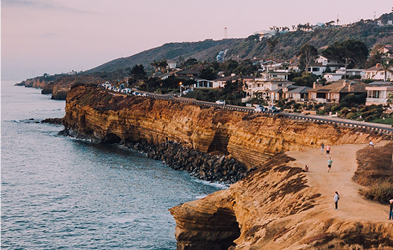As a border region, San Diego inherently has an interdependent environmental, economic and cultural relationship with Baja Norte of Mexico – the coastal landscape between the Pacific Ocean and the Gulf of California that includes cities like Tijuana, Rosarito and Ensenada.
Along with a land border, San Diego and Baja Norte share a curved coastline known as the Southern California Bight, a 430-mile coastline extending from Point Conception in Santa Barbara County to Punta Colonet in Mexico.
Altogether, this binational coastal region is home to more than 22 million people, hosts a wide range of industrial, military, and recreational activities and is considered one of the most productive coastal ecosystems in the Americas.
It is also the site of some of the largest environmental concerns.
Recent events like the oil spill off Huntington Beach and ongoing sewage issues from the Tijuana River highlight the need for solutions that transcend national borders.
That’s where building coastal resilience becomes important.
Coastal resilience is the ability of a coastal system to absorb and withstand shocks and disturbances from climate disasters including earthquakes, storms and floods, and to quickly return to either its pre-disaster state or a new state of balance where inhabitants can thrive.
The impacts of climate change are interconnected issues that are critical for the health and safety of all who reside in this binational region.
Environmental, Economic and Cultural Impact
There are a number of reasons why coastal resilience takes on shared importance for the San Diego-Baja Norte regions:
- We share the same environment. What happens in the water affects what happens on land, and vice versa. For example, a change in temperature in the ocean can lead to changes in weather patterns on land.
- Our economies overlap. The health of the environment and the ability to use natural resources in a sustainable way directly affect the economy. The tourism industry, for example, is dependent on a healthy environment with beautiful beaches and clean air and water. The fishing industry also depends on a healthy environment, as does agriculture.
- The culture is interconnected. The way we live our lives affects the environment, which in turn affects our cultures. For example, if we pollute the environment, it affects the cultural value we place on nature. Pollutants also impact indigenous cultures who have ceremonies and rituals related to the land and water.
In addition to the large population that resides in our binational region, the coastline is also an important economic engine for both the U.S. and Mexico.
The binational region alongside the Southern California Bight is home to a number of major ports, including the Port of Los Angeles and the Port of Long Beach – two of the busiest ports in the world. Coastal resilience investments help to ensure that these vital economic hubs are able to continue operating in the face of coastal hazards, such as sea level rise and storms.
Also, our binational region has a rich cultural heritage, with a number of important historical and archaeological sites located along the coastline. Coastal resilience investments help to protect these irreplaceable cultural resources from the impacts of coastal hazards.
Building coastal resilience is essential for protecting the safety, economic prosperity and cultural heritage of our binational region.
Investing in Coastal Resilience-Building Activities
There are a few different ways we can invest in coastal resilience-building activities:
- Research: We can invest in research to better understand the impacts of climate change and sea level rise on our coastline, and to develop strategies for mitigating those impacts. By investing in research, we can develop the best strategies for protecting our coastline from the impacts of climate change.
- Infrastructure: We can also invest in infrastructure projects that will improve our coastal resilience, such as seawalls, beach nourishment, and stormwater management systems. By investing in infrastructure projects, we can improve our ability to withstand natural disasters and coastal erosion.
- Education: Finally, we can invest in outreach and education campaigns to help people understand the importance of coastal resilience and how they can help protect their community.
By working together we can help advance equity and deliver resources and solutions to vulnerable coastal communities, making our binational region a more resilient place to live and work for all who call it home.
Climate Resilience
By fighting against the negative impacts of climate change, we can keep San Diego – and our interconnected regions – beautiful.
Through our Environment initiatives at SDF, we partner with local and international organizations to preserve and protect our resources, build a more sustainable path of economic growth and ensure a higher quality of life for those who call San Diego home.
Learn more about our Environment programs and initiatives today.




